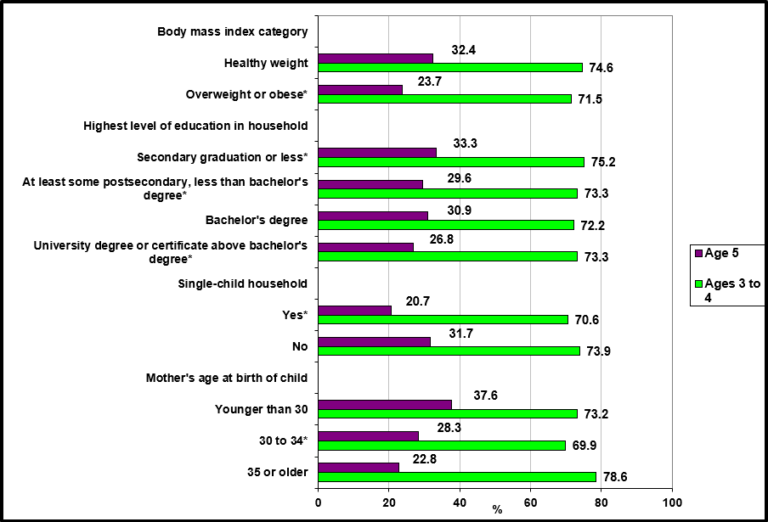3.3.3 Proportion of children aged 3 to 5 years that meet recommended guidelines* for physical activity, by selected characteristics, Canada, 2009 to 2013 (combined)

Notes:
*According to the Canadian Physical Activity Guidelines for the Early Years (0 – 4 years): Infants (aged less than 1 year) should be physically active several times daily – particularly through interactive floor-based play; Toddlers (aged 1–2 years) and preschoolers (aged 3–4 years) should accumulate at least 180 minutes of physical activity at any intensity spread throughout the day; Children are to progress toward at least 60 minutes of energetic play by age 5. http://www.csep.ca/CMFiles/Guidelines/CSEP_PAGuidelines_early-years_en.pdf – accessed June 21, 2017.
**Age 5 use with caution.
Source: CICH graphic created using data adapted from the Canadian Health Measures Survey, combined 2009-to-2011 and 2012/2013. http://www.statcan.gc.ca/pub/82-003-x/2016009/article/14653/tbl/tbl04-eng.htm –
accessed june 22, 2017; and, Statistics Canada. Health Reports. Physical activity and sedentary behaviour of Canadian children aged 3 to 5. Research article, Catalogue no. 82-003-X, Vol. 27, no. 9, pp. 14-23, September 2016. http://www.statcan.gc.ca/pub/82-003-x/2016009/article/14653-eng.htm -accessed June 22, 2017.
Between 2009 and 2013, the proportions of children 3 to 4 year-olds who met the recommended guidelines for physical activity (at least 180 minutes of physical activity every day) were: 74.6% for children with a healthy weight versus 71.5% for children overweight or obese and 70.6% for children in single-child households versus 73.9% for children in non-single-child households.
During the same period, the proportion of children 5 years old who met the recommended guidelines for physical activity for their age group (at least 60 minutes of moderate-to-vigorous physical activity every day) was 32.4% for children with a healthy weight versus 23.7% for children overweight or obese and 20.7% for children in single-child households versus 31.7% for children in non-single-child households.
For more details about these data, including statistical significance, refer to Statistics Canada.1
1Statistics Canada. Health Reports. Physical activity and sedentary behaviour of Canadian children aged 3 to 5. Research article, Catalogue no. 82-003-X, Vol. 27, no. 9, pp. 14-23, September 2016. http://www.statcan.gc.ca/pub/82-003-x/2016009/article/14653-eng.htm-accessed June 22, 2017.
Implications
The stigmatization of children, youth and adults who are overweight is pervasive in our society – and results in discrimination. There are many weight-based stereotypes – for example that overweight and obese children and youth are lazy and weak-willed. Often time, obese children and youth are blamed for their weight. Some even justify weight stigmatization arguing that it may motivate people to engage in healthier behaviours. This has major consequences for the physical and psychological health of children and youth.2 There is increasing evidence to show that weight discrimination negatively affects weight-related behaviours – for example, limiting physical activity. That is, children and youth are more likely to avoid physical activity because of being stigmatized.3,4,5
2Puhl RM, Heuer CA. Obesity stigma: important considerations for public health. Am J Public Health. 2010;100(6):1019-28.
3Puhl RM, Luedicke J. Weight-based victimization among adolescents in the school setting: emotional reactions and coping behaviors. J Youth Adolesc 2012;41:27–40. ↵
4Barkley JE, Salvy SJ, Roemmich JN. The effect of simulated ostracism on physical activity behavior in children. Pediatrics2012;129:e659–666.
5Jackson SE, Steptoe A. Association between perceived weight discrimination and physical activity: a population-based study among English middle-aged and older adults. BMJ Open 2017;7:e014592.
